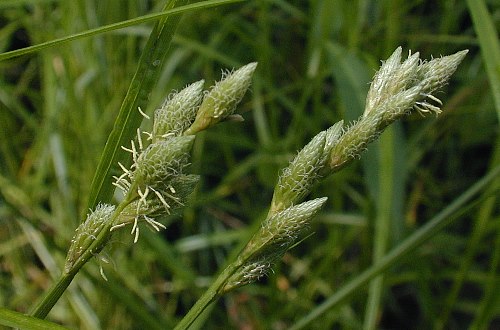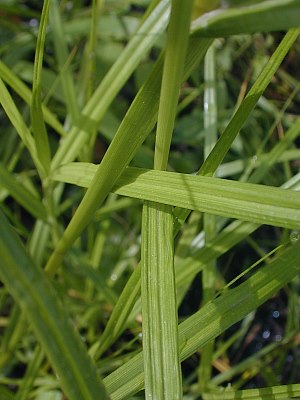Description: This perennial sedge forms a tuft of culms and leaves up to 3' tall. Both fertile and infertile shoots are produced; the latter tend to be more leafy. The culms are light to medium green, glabrous, and 3-angled. The edges of each culm are rough-textured toward the apex, but they become more smooth below. Fertile shoots have 5-10 alternate leaves along each culm, while infertile shoots have 8-12 alternate leaves (if not more). These leaves are distributed evenly along the length of each culm. The leaf blades are up to 12" long and 3-5 mm. across; they are medium green, glabrous, and widely spreading. The leaf sheaths are light to medium green and glabrous. The summit of each sheath is concave or V-shaped, where it is membranous underneath.

Each fertile culm
terminates in a narrow inflorescence with 5-12 spikelets; this
inflorescence is about 5-9 cm. long, 1 cm. across, and erect to
slightly arching. Immature spikelets are light green, but they later
become brown. Each spikelet is about 2 cm. long, 3-4 mm. across, and
narrowly ellipsoid in shape; it is pointed at the top and wedge-shaped
at the bottom. A spikelet consists of a dense cluster of florets and
their scales; staminate (male) florets are located toward the bottom,
while pistillate (female) florets are located toward the middle and top
of the spikelet. The anthers of the male florets are pale yellow or
white and cylindrical in shape, while the styles of the female florets
are slender and white. Each female floret has a perigynium that is 6–8
mm. long and 1.8–2.0 mm. across; it is narrowly lanceolate-elliptic in
shape, tapering to a long beak at the apex and becoming wedge-shaped
toward the bottom, where it is occasionally short-truncate. The
upper-middle margins of each perigynium are slightly winged and
membranous. Each pistillate scale is about 1/2 to 2/3 the length of its
perigynium; it is lanceolate-oblong in shape with a green midvein and
membranous margins (later turning brown). The bracts of the spikelets
are mostly scale-like and insignificant, although the bract of the lowest spikelet may
resemble a small leaf. The blooming period occurs during the late
spring to early summer. Each fertile female floret produces an achene
about 2.0–2.5 mm. in length, which is oblongoid in shape and flattened;
it is contained with the perigynium. Because the perigynia are very
light, they are easily blown about by the wind or carried on water,
thereby distributing the achenes. The root system is fibrous and
rhizomatous. This sedge forms vegetative offshoots from its rhizomes.
and insignificant, although the bract of the lowest spikelet may
resemble a small leaf. The blooming period occurs during the late
spring to early summer. Each fertile female floret produces an achene
about 2.0–2.5 mm. in length, which is oblongoid in shape and flattened;
it is contained with the perigynium. Because the perigynia are very
light, they are easily blown about by the wind or carried on water,
thereby distributing the achenes. The root system is fibrous and
rhizomatous. This sedge forms vegetative offshoots from its rhizomes.
Cultivation:
Muskingum Sedge prefers partial sun to light shade, wet to moist
conditions, and a fertile loamy soil to sustain its prodigious growth.
Range & Habitat:
The native Muskingum Sedge is scattered throughout Illinois (see Distribution
Map). It is more common in NE and extreme southern Illinois
than other areas of the state. Habitats include swamps, soggy woodlands
along rivers, and sedge meadows. This conservative sedge is usually
found in shaded or partially shaded swampy areas where some of the
original ground flora is still intact.
Faunal Associations:
The caterpillars of several moths, skippers, and butterflies feed on
the foliage of Carex spp. (sedges); see the Lepidoptera
Table for a list of these species. Leafhoppers that suck
juices from sedges include Cosmotettix bilineatus, Cosmotettix
luteocephalus, Cosmotettix marginatus,
and Elymana inornata; another insect-feeder is the
spittlebug Paraphilaenus parallelus. Several leaf
beetles
(Chrysomelidae) feed on the foliage of sedges; these species include Donacia
porosicollis, Plateumaris aurifera, Plateumaris
diversa, Plateumaris dubia, Plateumaris
flavipes, Plateumaris fulvipes, Plateumaris
robusta, and Poecilocera harrisii. Many
birds eat the seeds or seedheads of sedges. In the swampy habitats of
Muskingum Sedge, these species would include the Mallard, Wood Duck,
Woodcock, Swamp Sparrow, Song Sparrow, and Red-Eyed Towhee. Some
mammals use sedges as a food source to a limited extent. These mammals
include the Black Bear (seedheads, leaves), Fox Squirrel (seedheads),
Gray Squirrel (seedheads), and Meadow Vole (leaves, seeds, rhizomes).
Because Muskingum Sedge is quite robust and often forms colonies, it
can provide significant cover to wildlife during the summer.
Photographic Location:
A swampy woodland in Vermilion County, Illinois.

Comments: This interesting sedge is very leafy and rather tall (up to 3'). Muskingum Sedge is fairly easy to identify because its spikelets (½–1" in length) are more elongated and pointed than those of similar sedges; its perigynia are also unusually long and slender (at least ¼" in length). Because the widely spreading leaf blades are densely arranged along the entire length of the culms (particularly toward the apex of vegetative shoots), this species is sometimes called 'Palm Sedge.' Cultivated forms of this sedge can be found in Europe. The common name, 'Muskingum Sedge,' refers to a river in Ohio.